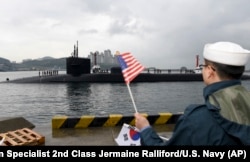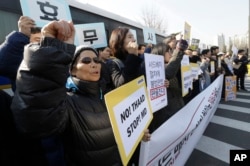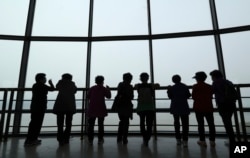Amid growing tensions over North Korea's missile and nuclear programs, the U.S. military Wednesday began moving some parts of the THAAD anti-missile defense system onto a deployment site in South Korea, Seoul said.
"South Korea and the United States have been working to secure an early operational capability of the THAAD system in response to North Korea's advancing nuclear and missile threat," South Korea's defense ministry said in a statement.
The first elements of the Terminal High Altitude Area Defense system were delivered to South Korea in early March. On Wednesday, South Korea's defense ministry said other elements were moved onto a deployment site — a former golf course — in Seongju county.
South Korea and the United States said the sole purpose of the advanced THAAD system is to defend against missile launches from North Korea.
While China opposes THAAD, calling it a threat to its own security, it has spoken out against North Korea's missile and nuclear tests and has supported U.N. sanctions against Pyongyang.
Failed missile test
Most recently, on April 16, North Korea conducted a failed missile test in defiance of increased U.S. warnings that there would be serious consequences for such provocative actions, including a possible military response. North Korea also is believed to be preparing for a sixth nuclear weapons test.
On Tuesday, North Korea marked the 85th anniversary of the founding of its military with a "massive fire drill" in the eastern port city of Wonsan, according to South Korea's defense ministry.
The celebration came on the same day a U.S. nuclear-powered submarine, the USS Michigan, arrived in South Korea, and the navies of those two countries joined Japan in conducting military exercises in the waters west of the Korean Peninsula.
The naval exercises are scheduled to last through Wednesday, the same day President Donald Trump has invited all 100 U.S. senators to the White House for a classified briefing that will primarily concern North Korea.
Defense Secretary Jim Mattis, Secretary of State Rex Tillerson, Director of National Intelligence Dan Coats and General Joe Dunford, chairman of the Joint Chiefs of Staff, will conduct the briefing.
While lawmakers often receive classified briefings on Capitol Hill, it is rare for them to take place at the White House and for the entire Senate to be involved in one event.
Wednesday's briefing will be held in the auditorium of the Eisenhower Executive Office Building, next to the White House.
'A big world problem'
During a White House lunch with ambassadors of U.N. Security Council member states on Monday, the U.S. president called unacceptable the "status quo in North Korea." Trump said the Security Council must be prepared to impose additional and stronger sanctions on North Korea's nuclear and ballistic missile programs.
"North Korea is a big world problem, and it's a problem we have to finally solve," the president added. "People have put blindfolds on for decades, and now it's time to solve the problem."
Several U.S. senators were looking forward to hearing from the White House on North Korea.
Senator Ben Cardin of Maryland, the top Democrat on the Senate Foreign Relations Committee, told Reuters, "I hope that we hear their policy as to what their objectives are, and how we can accomplish that hopefully without dropping bombs."
Republican Senator Lindsey Graham of South Carolina told Reuters the Trump administration should be telling senators if it has a "red line."
VOA's Steve Herman at the White House and Brian Padden in Seoul contributed to this report.












